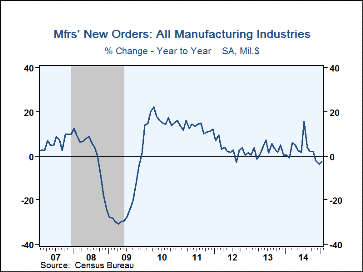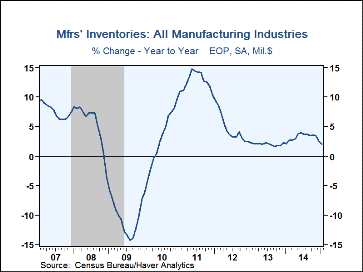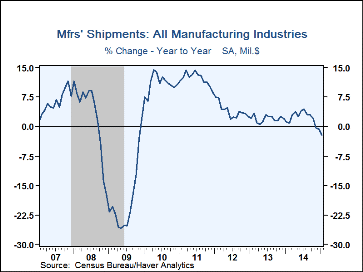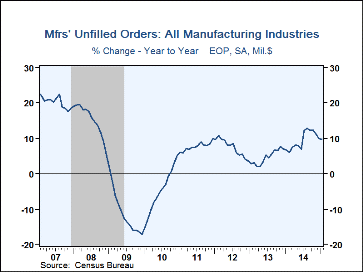 Global| Mar 05 2015
Global| Mar 05 2015U.S. Factory Sector Orders Slip; Inventories Decline Again
by:Tom Moeller
|in:Economy in Brief
Summary
New orders in the manufacturing sector slipped 0.2% (-2.3% y/y) following a little-revised 3.5% December decline. The fall was the sixth in as many months and roughly matched expectations in the Action Economics Forecast Survey for a [...]
New orders in the manufacturing sector slipped 0.2% (-2.3% y/y) following a little-revised 3.5% December decline. The fall was the sixth in as many months and roughly matched expectations in the Action Economics Forecast Survey for a 0.3% slip.
Durable goods orders increased 2.8% last month and were up 5.5% y/y. The gain was unrevised from the advance durable goods figure. Transportation orders jumped 9.7% (8.3% y/y) as nondefense aircraft orders surged. Machinery orders gained 1.4% (-2.4% y/y) and computers & electronic equipment orders improved 1.7% (6.1% y/y). Electrical equipment bookings, however, dropped 3.8% (+0.5% y/y). Orders for nondurable goods (which equal shipments) declined 3.1% (-9.1% y/y) as the value of petroleum shipments fell 11.7% (-36.7% y/y) due to lower prices. Basic chemical shipments declined 1.3% (-3.1% y/y). Apparel shipments fell 2.1% (+15.1% y/y) and food product shipments slipped 0.2% (+3.9% y/y). Durable goods shipments declined 1.0% (+5.7% y/y) led by a 1.5% fall (3.5% y/y) in machinery shipments. Electrical equipment & appliance shipments were off 0.7% (+4.2% y/y).
Unfilled orders declined 0.2% (+9.8% y/y) while backlogs excluding the transportation sector slipped 0.1% (+5.9% y/y). Machinery backlogs declined 0.3% (+5.3% y/y) and unfilled orders for transportation equipment also fell 0.3% (+12.2% y/y). Order backlogs of computers & electronic products gained 0.5% (7.6% y/y) while unfilled orders of furniture edged 0.1% higher (10.7% y/y).
Inventories were off 0.4% (+2.0% y/y) following a like decline in December. Inventories excluding the transportation sector fell 0.6% (+0.3% y/y). Nondurable goods inventories led the decline with a 1.7% fall (-4.3% y/y) that reflected an 10.2% drop (-19.2% y/y) in petroleum inventories. Nondurable inventories excluding oil slipped 0.1% (+1.3% y/y). Basic chemical inventories fell 0.6% (-0.1% y/y) but apparel inventories gained 1.7% (26.7% y/y). Textile mill inventories edged 0.4% lower (+1.2% y/y) and paper products inventories gained 0.5% (3.0% y/y).
The factory sector figures are available in Haver's USECON database.
| Factory Sector- NAICS Classification (%) | Jan | Dec | Nov | Y/Y | 2014 | 2013 | 2012 |
|---|---|---|---|---|---|---|---|
| New Orders | -0.2 | -3.5 | -1.7 | -2.3 | 2.8 | 2.7 | 2.9 |
| Shipments | -2.0 | -0.9 | -1.0 | -2.1 | 2.3 | 2.0 | 4.0 |
| Inventories | -0.4 | -0.4 | 0.0 | 2.0 | 2.5 | 2.3 | 2.4 |
| Unfilled Orders | -0.2 | -0.9 | 0.2 | 9.8 | 9.9 | 7.0 | 3.7 |
Tom Moeller
AuthorMore in Author Profile »Prior to joining Haver Analytics in 2000, Mr. Moeller worked as the Economist at Chancellor Capital Management from 1985 to 1999. There, he developed comprehensive economic forecasts and interpreted economic data for equity and fixed income portfolio managers. Also at Chancellor, Mr. Moeller worked as an equity analyst and was responsible for researching and rating companies in the economically sensitive automobile and housing industries for investment in Chancellor’s equity portfolio. Prior to joining Chancellor, Mr. Moeller was an Economist at Citibank from 1979 to 1984. He also analyzed pricing behavior in the metals industry for the Council on Wage and Price Stability in Washington, D.C. In 1999, Mr. Moeller received the award for most accurate forecast from the Forecasters' Club of New York. From 1990 to 1992 he was President of the New York Association for Business Economists. Mr. Moeller earned an M.B.A. in Finance from Fordham University, where he graduated in 1987. He holds a Bachelor of Arts in Economics from George Washington University.










